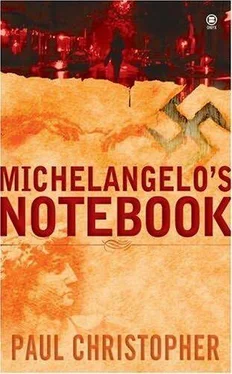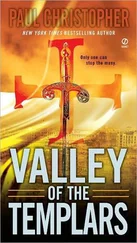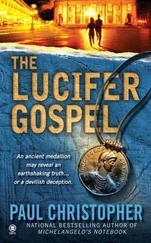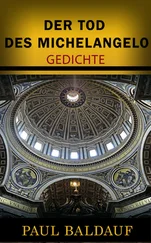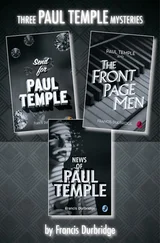Paul Christopher - Michelangelo_s Notebook
Здесь есть возможность читать онлайн «Paul Christopher - Michelangelo_s Notebook» весь текст электронной книги совершенно бесплатно (целиком полную версию без сокращений). В некоторых случаях можно слушать аудио, скачать через торрент в формате fb2 и присутствует краткое содержание. Жанр: Триллер, на английском языке. Описание произведения, (предисловие) а так же отзывы посетителей доступны на портале библиотеки ЛибКат.
- Название:Michelangelo_s Notebook
- Автор:
- Жанр:
- Год:неизвестен
- ISBN:нет данных
- Рейтинг книги:5 / 5. Голосов: 1
-
Избранное:Добавить в избранное
- Отзывы:
-
Ваша оценка:
- 100
- 1
- 2
- 3
- 4
- 5
Michelangelo_s Notebook: краткое содержание, описание и аннотация
Предлагаем к чтению аннотацию, описание, краткое содержание или предисловие (зависит от того, что написал сам автор книги «Michelangelo_s Notebook»). Если вы не нашли необходимую информацию о книге — напишите в комментариях, мы постараемся отыскать её.
Michelangelo_s Notebook — читать онлайн бесплатно полную книгу (весь текст) целиком
Ниже представлен текст книги, разбитый по страницам. Система сохранения места последней прочитанной страницы, позволяет с удобством читать онлайн бесплатно книгу «Michelangelo_s Notebook», без необходимости каждый раз заново искать на чём Вы остановились. Поставьте закладку, и сможете в любой момент перейти на страницу, на которой закончили чтение.
Интервал:
Закладка:
Grist to your mill. She grinned at that, picked up a stenographer’s notebook and a pencil from the stationery cupboard and went down the row of paper storage units to where she’d been working yesterday. After getting her degree, she’d spent a year in Florence, studying in Michelangelo’s birth-place, walking where he’d walked and learning the language as well. Now that was grist to her mill, even if it did involve getting her butt pinched black-and-blue by everyone from the guy in the archives office to the goofy old priest in the library at Santo Spirito.
She wouldn’t be mounting seminal shows of the works of Renaissance Florentine painters her first day on the job. Besides, she’d been promised that if she did well as an intern she’d be given a paid position next year. She wanted to be able to live in New York while getting her master’s, but it was expensive, even when renting an Alphabet City dump like she did.
Willie appeared again, going on his rounds, fitting his key into the watchman’s box and moving on. Other than that, the whole department seemed empty, which was just the way she liked it. She found the drawer she’d been working on yesterday, slipped on a pair of regulation white cotton gloves and started to work, jotting down numbers from the acetate covers on the drawings and then taking the numbers and sometimes the drawing itself to the niche to be compared to the information on the computer database.
After two hours she was yawning and seeing double but she kept at it. She finished one drawer and then started on the next, this one so low she had to drop down into a squat to get the drawer open. From that angle, she saw that one of the drawings had slipped into a small crack at the back of the drawer and was almost invisible. Unless the drawer was completely open it would be easy to overlook.
Finn carefully pulled open the drawer as far as she could, then reached in blindly, feeling for the small edge of acetate she’d seen. It took a while, but she finally got her thumb and forefinger on it and gently pulled. Eventually it came free and Finn brought it into the light. She lifted it up to the top of the paper storer and used her toe to push the drawer closed while she took a closer look at the drawing. She almost fainted.
The drawing was approximately six inches by eight inches, rough cut at the left side or perhaps torn. Even through the acetate cover she could see that the paper was in fact high-quality parchment, probably lambskin, rubbed with chalk and pumice. At one time or another it had been part of a notebook, because at the bottom corner she could see evidence of stitching.
The illustration was done in a sepia ink, so old the lines had faded to spidery near-invisibility. The quality of the work was masterful, clearly dating from the Renaissance. It was a woman; the large breasts were clearly visible. She was wide hipped, almost fat. The head was not in the drawing, nor were the lower limbs or the arms.
What was extraordinary was the fact that the woman’s body appeared to have been sliced open straight up the midline and the flesh and rib cage completely removed. The neck had been opened as well, revealing both the light tube of the jugular vein and the thicker and much more prominent carotid artery running up to and behind the ear. The lungs were bared as were the kidney and heart.
The liver was prominent and neatly drawn but the stomach appeared to have been removed to give a better view of the uterus and the opened vaginal barrel leading down from it. The cervix was carefully drawn in as were the labia at the other end. Ligaments and muscles supporting the uterus and the other organs were carefully included as were all the major veins and arteries of the circulatory system.
It was a beautifully rendered anatomical autopsy drawing of what appeared to be a middle-aged woman. There was only one thing wrong. Autopsies were not done in the Renaissance; it was called vivisection and the penalty for doing it was death. Leonardo da Vinci had been accused and tried for it although the charges had been dropped. Michelangelo, da Vinci’s contemporary, had been accused but never brought to trial.
Over the years the memoirs of other artists and intellectuals stated that Michelangelo had, with the collusion of the church’s prior, used the dead room at the Santo Spirito infirmary in Florence to do his drawings of bodies, but since Michelangelo’s mythical notebook had never come to light there was no proof.
Finn continued to stare at the drawing. She had spent a year in Florence and most of that time was spent studying the work and times of Michelangelo. Even the writing running down the left and right sides of the drawing looked like examples she’d seen of his small, angular script. Without even pausing to think about it she went to her pack and took out her little Minolta digital. She knew she’d catch hell if she was caught but she also knew she had to have an image of this to study at her leisure. It would be a perfect illustration for her thesis. Alex Crawley, the director of the Parker-Hale, was a stickler for policy, and there would be an endless stream of documentation, permissions and just plain paperwork before he allowed her to even so much as think of taking pictures. She took a dozen quick shots then put the camera back in her pack, relieved that no one had seen her.
She carefully picked up the drawing, carried it to the light table and examined it more carefully, using a jeweler’s loupe from the desk drawer. The handwriting was too faded to make out the words but she presumed it was notations made on the dissection of the woman’s body.
According to existing documentation, when someone died at the Santo Spirito infirmary they would be placed in the dead room, wrapped in a sheet overnight then sewn into a shroud and placed in a coffin the following day. Given a copy of the iron key to the dead room, Michelangelo would sneak in at night, dissect the corpse to examine whatever section of the body he was interested in at the time and sneak out again before morning.
He was supposed to have used some strange metal device to hold a candle at his forehead to light his way but Finn wasn’t sure she believed it. She’d been given a tour of Santo Spirito, including the dead room. From what she’d read of the economics of the time she was reasonably sure money had changed hands between the artist and the prior. She was also fairly sure that the rumors and stories were true.
Now she was positive-the drawing she was looking at had not been drawn from memory but from life, or rather death. It slowly dawned on her what she had discovered: this was an actual page from the near mythical Michelangelo’s notebook. Finn even knew who had done the binding: Salvatore del Sarto, the binder friend of Michelangelo’s who regularly bound together the sheets of cartoons he used to apply his frescoes. But why was it shoved in the back of a drawer in the Parker-Hale and how did it get here?
She checked the inventory number on the acetate covering and jotted it down in the stenographer’s notebook. Taking the notebook down to the next niche with a computer in it she logged on, typed in the number and requested the scanned slide representation. Oddly there was none, just a blank white screen and the notation “Not Filed.” She went back to the main menu and asked for any documentation relating to the inventory number and was given the name of a minor Venetian artist she vaguely remembered reading about named Santiago Urbino and a second number that took her back to the main menu and the provenance documentation files. The cross-index of image, artist and provenance all matched.
According to the computer file the drawing was by Urbino, had been purchased from a private collection by the Swiss branch of the Hoffman Gallery in 1924, sold again to Etienne Bignou Gallerie in Paris in 1930, to the Rosenberg Gallery in 1937 and finally from the Hoffman Gallery again, sold to William Whitehead Hale on his last trip to Europe before the war in 1939. It had been part of the permanent collection of the museum ever since.
Читать дальшеИнтервал:
Закладка:
Похожие книги на «Michelangelo_s Notebook»
Представляем Вашему вниманию похожие книги на «Michelangelo_s Notebook» списком для выбора. Мы отобрали схожую по названию и смыслу литературу в надежде предоставить читателям больше вариантов отыскать новые, интересные, ещё непрочитанные произведения.
Обсуждение, отзывы о книге «Michelangelo_s Notebook» и просто собственные мнения читателей. Оставьте ваши комментарии, напишите, что Вы думаете о произведении, его смысле или главных героях. Укажите что конкретно понравилось, а что нет, и почему Вы так считаете.
